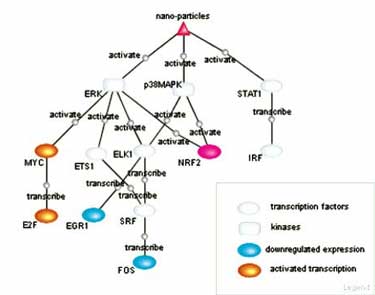APPLICATIONS OF TECHNOLOGY:

Activated signal transduction network for higher dose responses to carbon nano-onions. (See the publication link for further explanation.) EGFR is a gene upstream of the p38MAPK protein shown in this network.
Response to Carbon Nano-onion Treatment
- Tumor therapy
- Infrared photosensitizing of cancer cells
- PET or MRI imaging reagents
ADVANTAGES:
- A slow diffusion rate promises a longer lasting, localized, therapy
- Few significant side effects are anticipated
- More efficient than fullerenes in optothermal conversion
DESCRIPTION:
Using genome expression array analysis, Fanqing Chen of Berkeley Lab has shown that human skin cells treated with multiwall carbon nano-onions (MWCNOs) show a fourfold reduction in HER1/EGFR expression, a gene overexpressed by 30-35% of human breast cancer tumors.
Many studies have reported that HER1/EGFR is also disregulated invarious other tumor types. In addition, HER1/EGFR overexpression correlates with disease progression, poor prognosisand reduced sensitivity to chemotherapy. Several strategieshave been developed to target HER1/EGFR, including small-molecule tyrosine kinase inhibitors and monoclonalantibodies.1
Berkeley Lab’s nanotherapy, composed of a multiwalled nanomaterial conjugated to a tumor-targeting molecule and an imaging reagent, promises several advantages over these and other conventional cancer tumor treatments. The Berkeley Lab therapy is likely to be well localized and tumor-persistent since the nanomaterials have slow diffusion rates. At the concentrations necessary for treatment, they are also likely to generate fewer significant side effects than their chemical or biological competitors. In addition, MWCNOs are more potent than fullerenes, which are also being studied for tumor therapy. Berkeley Lab researchers began animals studies on the MWCNO therapeutic in June, 2006.
Dr. Chen demonstrated for the first time both 1) a phenotypic response of cells to MWCNTs and MWCNOs – cell cycle arrest and increases in apoptosis/necrosis, 2) and a corroborating global gene expression response at a cellular level. The nanomaterials activate genes involved in cellular transport, metabolism, cell cycle regulation, and stress response. These results provide the basis for studying an array of nanotoxicity mechanisms and discovering new targets for nanotherapy.
Berkeley Lab’s invention includes the use of MWCNOs for infrared photosensitizing of cancer cells. Nano-onions can also be doped with gadolinium for use as a MRI contrasting reagent and doped with radionucleotides for PET imaging.
STATUS: Issued U. S. Patent #8,785,505. Available for licensing or collaborative research.
FOR MORE INFORMATION SEE:
REFERENCE NUMBER: IB-2218a
SEE THESE OTHER BERKELEY LAB TECHNOLOGIES IN THIS FIELD:
- Predictive Methodology and Tools for Nanotoxicology , IB-2218

- Nanocrystals:
- Nanotubes: